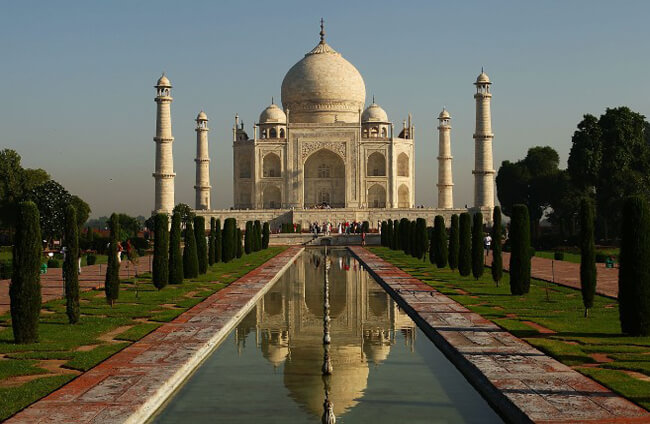-

 Know, the true nature of your Beloved.
Know, the true nature of your Beloved.
In His loving eyes, your every thought,
Word and movement is always –
Always Beautiful.
~ Hafiz
Sacred Architecture

The Taj Mahal
The Taj Mahal is the most famous example of Indian architecture – thought by many to be the finest building in the world.
It’s the most magnificent in a series of mausoleum complexes built by the emperors of the Mughal dynasty. What is notable is that the emperor Shah Jahan built this grandest of all the Mughal mausoleums for a woman – his wife, Mumtaz Mahal. This romantic inspiration has long appealed to visitors over the centuries, with the tomb becoming known as a monument of love, it’s perfect aesthetics reflecting the pure sentiment to which it owed its existence.
Of the six generations of outstanding Mughal rulers, Shah Jahan, Akbar and Jahangir especially saw themselves as representatives of God on earth, who united both spiritual and political authority. Under Shah Jahan, ‘King of the World’, the Mughal empire experienced its period of greatest prosperity and stability. This golden age emphasized architecture and arts as indispensable instruments of rulership, that were to be seen as evidence of the balance and harmony of the empire.
Shah Jahan was so delighted when he married Arjumand Banu Begam, that Shah Jahan’s historian Qazwini recorded, “finding her in appearance and character elect (mumtaz) among all the women of his time, he gave her the title of ‘Mumtaz Mahal Begam’ – ‘Chosen One of the Palace’. He would later also call her ‘Cradle of Excellence’. Their marriage was a true love story. During their marriage, Mumtaz Mahal continued the Mughal tradition of female architectural patronage by building a beautiful garden at Agra.
Shah Jahan was deeply shocked at the death of Mumtaz Mahal, which prompted him to observe a strict two year mourning period. Mumtaz was temporarily buried, where Shah Jahan would regularly visit on Fridays to recite Surat al-Fatiha over her grave. It was at this time that the planning of the Taj Mahal began.
Today the complex of the Taj Mahal stands almost by itself on the bank of the river Jamna. Originally, however, it formed part of the urban landscape of Mughal Agra, the core of which consisted of bands of many gardens and buildings lining both sides of the river. The Taj Mahal itself was part a vaster complex, being divided into two zones – the mausoleum and the ‘worldly’ component, reflecting the dialectic Islamic concept of the ‘akhira’ and the ‘dunya’: the hereafter and this world. The ‘akhira’ zone consists of the mausoleum, a mosque and an assembly hall, set in a garden and reached through a monumental gate. To its south was the worldly large bazaar and caravanseri complex, which served the funerary complex in a way that was not only functional but also formal, as the servant area echoed the plan of the area served. By providing quarters for travellers and merchants, “the whole world could see and admire its magnificence’, as described by Tavernier in the mid-17th century.
The Taj Mahal was designed to be a magnificent burial place for Mumtaz Mahal, an image here on earth of the heavenly mansion prepared for her in Paradise and to also to be a testament to the power and glory of the Mughal rule ‘until the Day of Resurrection’, as recorded by Qazwini. The architectural principles of the Taj Mahal incorporate the following:-
– Geometrical planning:- the elements and features of the complex are integrated into the overall scheme combining various grids, two triangular geometries and an octagonal geometry, with remarkable dexterity.
– A concept of bilateral symmetry known as ‘qarina’, which means ‘companion’ or ‘female friend’, consisting of two equal features arranged symmetrically on either side of a central axis.
– A hierarchical grading principle that governs the use of materials, forms and colours, employed to even the most minute ornamental detail.
– Proportional formulas expressed in triadic divisions.
– Uniformity of shapes, ordered by hierarchical accents.
– A selective use of naturalism.
As Paradise in the Quran is represented by gardens, flowers and plants were used as permanent decoration throughout the Taj Mahal. In contrast to that of human figures, this was acceptable to Islamic scholars. This explains why the courts of the three great empires of the Islamic world – the Ottomans, the Safavids and the Mughals used floral decoration to provide a lasting paradisical quality to their architecture.
Source:- ‘The Complete Taj Mahal’ by Ebba Koch.
